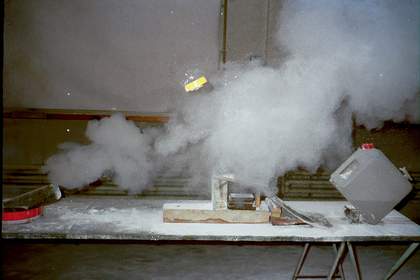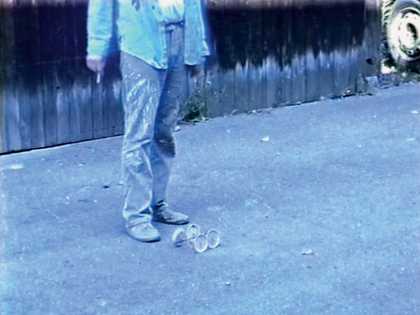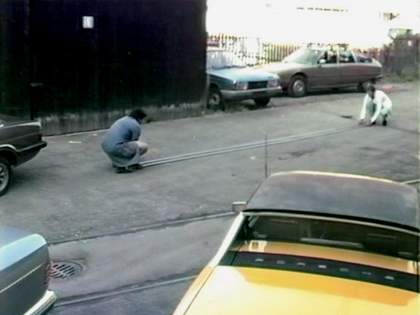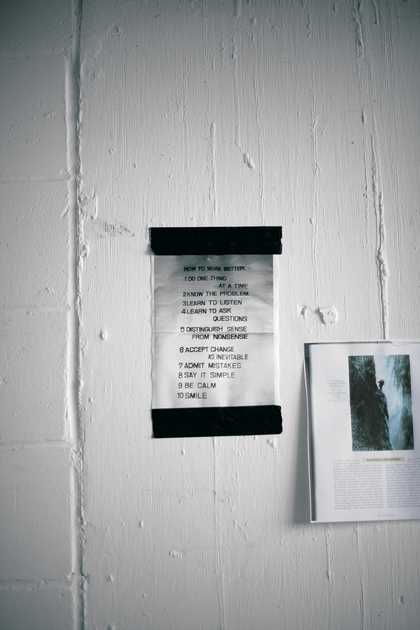
Peter Fischli and David Weiss
The Way Things Go 1987
Film still
Camera: Pio Carradi
Courtesy Galerie Eva Presenhuber, Zurich © Peter Fischli and David Weiss

Peter Fischli and David Weiss
The Way Things Go 1987
Film still
Camera: Pio Carradi
Courtesy Galerie Eva Presenhuber, Zurich © Peter Fischli and David Weiss
Here we are in what looks to all intents and purposes like a storage depot for used car tyres. Two young men are crouching or sitting cross-legged on the floor, fiddling with something made of wire and plastic, which, as we shall later see, is meant to be a rocket-powered vehicle. The actual function of this construction does not really appear to be the main focus of interest. The structural components have been chosen in such a way that what we might be talking about is a kind of borderline functionality. As we are about to discover, it is meant to be on the verge of working (in fact, it hasn’t actually worked for a long time), and it is precisely this ‘on the verge’ effect that will develop in the most charming and unexpected way into a singularly entertaining and ironic take on functionality.
What is needed for this thing to work has, it seems, been found almost by chance among the clutter of stuff spread out around the constructors. The very word clutter itself conjures up the word clatter – a motley array of household items stacked so precariously that they are constantly in danger of clattering down around you. The two men love this element of risk. It fires their imaginations. And, young as they may be, they know full well that everything we make will one day be mere clutter. All things eventually go the way of gravity or wear and tear until they end up at the very bottom of the pile or dissolve completely into their component particles and are scattered around. That is, as it were, the irresistible wish of all things.
Thin pliable wire has been used for the construction of the chassis and axle. The wheels are made of flesh-coloured plastic. These are not wheels in the narrower sense of the word, but little coasters for glasses or small plant stands with a hole drilled through them. One of the two men will later remark how important it was that the hole for the axle was bored right through the middle of the round plastic disc. Were it not for the stack of tyres in the background – that soft, matt black, somnolent heap like a pneumatic memory of spent kinetic energy in the form of thousands of kilometres rolled – we might be tempted to think that these men had no idea the wheel had already been invented.
The two men clearly have unlimited time. Yet this does not seem to be leisure time. The same is true of the third person, who is initially behind the camera, but who gradually becomes involved in the expert discussion about how to attach the wheels to the wire frame and the little firework rockets to the vehicle. How long did it take back in the mists of time, when the very concept of leisure probably did not exist at all, to get from the invention of a round disc of stone to the development of hub and axle? Before the invention of the wheel and then the vehicle, there were beasts of burden. And before the beasts of burden? The very first vehicle was the helpmate – woman. That was a long time ago. But there is no sign of a woman here in this workshop with its wall of black car tyres.
It is 6 September 1985. In exactly 134 days the space shuttle will explode shortly after take-off, inscribing an eerily beautiful plume of white vapour in the sky. Another 88 days later, again due to a chain of human errors and structural faults, Chernobyl’s Block Four reactor will go into meltdown. This catastrophe was triggered by a maintenance test intended to determine whether the turbine could power the cooling pumps while freewheeling to a standstill during a power cut until the emergency supply kicked in 40 to 60 seconds later. Whether the uncontrollable meltdown was caused by the manually operated emergency shutdown at 01:23:40, or by the cooling system being turned off 36 seconds earlier, cutting off the turbine’s steam inflow, remains disputed.

Patrick Frey
Documentary on the making of Peter Fischli and David Weiss’s The Way Things Go 1987
Film still
Camera: Pio Carradi
Courtesy Galerie Eva Presenhuber, Zurich © Peter Fischli and David Weiss

Patrick Frey
Documentary on the making of Peter Fischli and David Weiss’s The Way Things Go 1987
Film still
Camera: Pio Carradi
Courtesy Galerie Eva Presenhuber, Zurich © Peter Fischli and David Weiss
The men are oblivious to the world around them. They are busy with their meagre materials. The film camera watches them building something and looking at each other as they do so. The camera observes how one of them assembles something and how the other takes it from him and dismantles it again. It watches them as they test and experiment, reject and test again. It watches them as they comment on the test results. At some point it becomes evident that this little rocket-driven vehicle, whimsical as it may look, is no toy, but part of some great masterplan in which even the smallest and most mundane thing, such as a piece of parcel tape, has a specific role to play. At one point, one of them rolls the wobbly chassis – or rather, the bit that will become the rear axle – to and fro and says: ‘Perfect.’ Then the other one says: ‘Perfect, is it? Hello! Logically speaking, it may be perfect, but. but.’ And the first man repeats: ‘But.’ and falls silent. A lengthy pause follows, in which the viewer is tempted to clarify the terms ‘logic’ and ‘perfection’ in this enigmatic situation of busy concentration. But then the work, if it can be called that – for the atmosphere seems bafflingly aimless and casual – continues, though the process of getting things going is excruciatingly slow.
Eventually, they do reach the point of lighting the fuses of the six rocket drives, outdoors and under mounting tension. There is howling, smoke, a couple of sputtering bangs – but the vehicle defies the elements and does not budge an inch. Perhaps it’s not so much the disastrous results of the first test-run as the almost rebellious obstinacy of the little vehicle that unleashes the first outburst of merriment in the two constructors.
It later becomes clear that this first wire-and-disc vehicle cannot be used, and that all their efforts have been in vain. In the background, we see a man, attracted by the pyroman(t)ic atmosphere, creating a new and more stable vehicle with a chassis of nailed wooden parts and planed wooden wheels that run on tracks – because the pusher affixed to the vehicle has to drive straight into a bolt that opens the vent that lets the air out of a balloon on which there is a weight attached to a string that pulls a lever, catapulting a lump of carbide into a pan of water in which a candle is burning.
But the story of the rocket-powered vehicle is just one small episode in this comic drama of rolling, burning, toppling, melting, falling things. In one of the next sequences, a tyre has to be rolled off a table along an angled surface and across two tilting planks. The thing with the tyre takes almost nine minutes, during which a number of curious, predominantly male, onlookers has gathered – some of them clearly experts – and when it finally does work, there are whoops and applause for both the men and the tyre. But we immediately realise that the real work is just starting now, for art, as it is portrayed here, is much like science: the experiment is deemed successful only if it can be repeated.
What happens in this film could be described in showbiz terms as rehearsals. And these rehearsals are still fairly rough; they are a long way from a polished performance. For minutes, or even hours, the collaborators take pleasure (albeit an increasingly dwindling pleasure) in their failure and then – many, many attempts later – even greater pleasure in their success. It is remarkable to see a handful of young men, some of them strangely dressed, barely able to contain themselves just because a little rocket-driven vehicle disappears around the corner with a bang and a puff of smoke. And yet this is precisely the mood we have witnessed in the control room of the Kennedy Space Centre when they finally have lift-off and the thing is safely on its way into orbit. But it is not just about succeeding. What these men here are experiencing is, not least of all, that boundless joy we get when we have seen once again that the course of things is absolutely irreversible. It is laughter at the merry mask of entropy, jubilation at the tail of sparks in a controlled explosion. Perhaps, though, that ‘we’ means only men. Female pyromaniacs are so very rare indeed that they are most likely to be found as the main character in a horror film. Men with a tendency towards pyromania, on the other hand, are standard variations of the species. This darker side of behaviour also includes the secret and at times utterly inappropriate pleasure of uncontrolled explosions. But I digress.
A review written in 1988 of the Fischli/Weiss exhibition at the ICA in London remarked that on a child’s scale of values, cars are almost as exciting as food. This assertion, of course, is both incorrect and incomplete. It needs the additional words: ‘And for grown men it stays that way.’ Besides which, ‘almost’ ought to be replaced with ‘at least’.

Peter Fischli and David Weiss
Fashion Show from Sausage Series 1979
Colour photograph
24 x 35 cm
© Courtesy Galerie Eva Presenhuber, Zurich © Peter Fischli and David Weiss
But this is not going to turn into a gender analysis of the film The Way Things Go. In 1985, at any rate, we were young men. Well, fairly young. It was 21 years ago that we all got together in this dusty workshop to gawp at the capers of a tyre, or to watch with fascination as a tensely bent saw-blade was released with a bang, triggering a sluggishly wobbling carbide catapult.I had been friends with Peter Fischli and David Weiss since 1980. I had curated a group exhibition (Bilder, 1981) with them before they started working together. I had written texts about their early works – about Sausage Series 1979, about Suddenly this Overview 1981, about the two Rat and Bear films and about Quiet Afternoon (Equilibre) 1984–5 that Peter and David had been working on immediately after their first major solo exhibition at Kunsthalle Basel in the early summer of 1985. It was their work on Quiet Afternoon that gave them the idea for The Way Things Go. The plan was that the threatened collapse of teetering structures should actually be allowed to happen and that the resulting energy should be used for an artistic relay race of objects. The first version was a relatively short loop, which Fischli/Weiss call Sketch for The Way Things Go: a three-minute Super-8 film, in which key sequences of the later 30-minute 16 mm film are outlined and tested.
The present film documentation was created during the three-day preparations for this ur-version of The Way Things Go. There was no specific brief. I didn’t know exactly what I would be filming. I was simply there. Peter and David seemed to be following a sometimes precise and sometimes vaguely sketched inner script. The objects did pretty much what they wanted, and I tried to capture as exactly as possible what was happening. At times, I would simply leave the camera running while I helped with the objects. That gave the camera plenty of time – uncut, about five and a half hours – to capture how the objects themselves, in the bizarre experimental arrangement of Fischli/Weiss, became actors and artists, providing enormous insight into the character of things. The camera was able to see how much effort it takes to persuade everyday objects, often with no discernible talent, to act as though they were being spontaneous and natural.
Two years later, critic David McCracken would write in the Chicago Tribune of the astonishing work involved in each relatively simple effect and counter-effect and ask: ‘How did they do it?’. This is an attempt to answer that question, but leaves even more questions unanswered.



